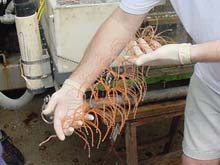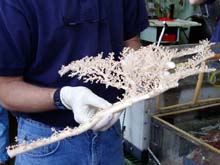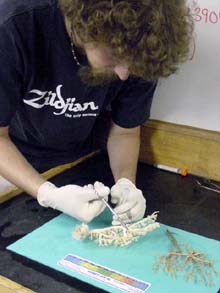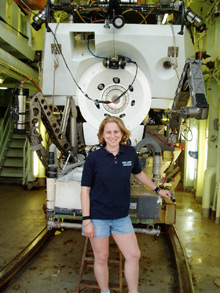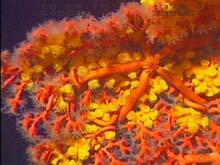
Deep sea Paragorgia coral covered in zoanthids and a sea star, demonstrating the beauty and diversity of life on the New England Seamounts! Click image for larger view.
Something of the marvelous
July 16, 2003
Pat Frisketti
Hamden High School
Diana Payne, Connecticut Sea Grant
Maya Crosby, Lincoln Academy
There is, one knows not what sweet mystery about the sea, whose gently awful stirrings seem to speak of some hidden soul beneath.
- Herman Melville, Moby Dick
In all things of Nature, there is something of the marvelous
- Aristotle
![]() Exploring the mysteries of seamounts. (mp4, 1.6 MB)
Exploring the mysteries of seamounts. (mp4, 1.6 MB)
DSV Alvin dive number 3904 was the Mountains in the Sea expedition’s second visit to Kelvin seamount. Observers Ivar Babb and Dr. Scott France and Alvin pilot Phil Forte were brought safely back on board the R/V Atlantis just in time for dinner. However, dinner would have to wait just a few moments.
The high point of each day is the return of the DSV Alvin to Atlantis. This event sets off a flurry of activity. Following successful recovery, there is some lag time as the submersible rolls along its track and back to the hanger. During this time, the science team has an informal but informative debrief session with the scientists who served as observers on the dive. On this cruise, most of the conversation has been filled with glowing descriptions and superlatives about the dive, including recitations of animal species noted that day. As soon as Alvin is secure, the researchers crowd around the bio box, as specimens are removed and immediately placed in labeled buckets of cold water to maintain the integrity of the animals. The buckets are then hauled off to cold storage - a walk-in refrigerator.
While the sub is down, the science labs are prepped so they are ready for the specimens to arrive. The activity is now focused on the proper documentation and preparation of the specimens.
Very little research actually takes place on board, but if the preparation phase is not managed properly, the specimen samples will be of very little value. It is important to correctly identify the location and collection station of each specimen. An initial identification of the organism is rendered, and any samples that prove to be descriptively interesting are given further scrutiny. The requirements of the researchers and collaborators from many different institutions must be considered during the preparation phase.
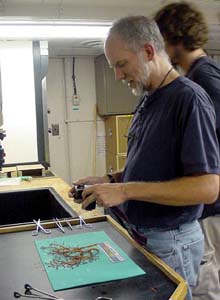
Dr. Jon Moore photographs an image of Paragorgia in the specimen preparation lab. This complete photograph is important for proper identification. Click image for larger view.
In a science laboratory on board Atlantis, Dr. Jon Moore, Dr. Scott France and Graduate Assistant Mercer Brugler are quite busy cataloging and preparing coral samples. The buckets are hauled from the walk-in freezer to the lab one at a time, where the documentation and cataloging of specimens begins. The creatures are first photographed in as complete a form as possible. This will be used for large-scale morphological identification. The beauty of some of these organisms is astounding. The conversation in the lab is never dull, and the tempo in the laboratory, aided by the ever-present music, is lively.
Once the animals have been photographed, parts of the specimens can be preserved for the specific needs of the different research objectives. Dr. Scott France and Mercer Brugler are interested in the coral genome, and are preserving specimens for PCR, (polymerase chain reaction). This requires obtaining tissue samples that include mainly the coral polyps (the soft part of the animal body with tentacles). To assure the specimens are appropriately preserved, Dr. France requires that two small samples are frozen and two larger samples are preserved in a 95 percent ethanol solution. The frozen samples are preferred, but all too often, freezers malfunction and samples are lost. This is why specimens are duplicated. Samples are also labeled twice - on the top and on the side - as labels have a tendency to come off. This redundancy saves data.
Meanwhile, Dr. Jon Moore is documenting specimens for a publication on the biodiversity of Western Atlantic Seamounts. He is interested in a wide range of organisms, and is also preserving specimens for colleagues from other institutions. Dr. Moore will take a piece of each coral and place it in a small amount of seawater. He then adds several flakes of methanol crystals and places the samples on ice. The methanol relaxes the corals, which have undergone a great deal of stress during collection. This stressed condition causes the coral to produce amazing amounts of mucus as protection. As the corals relax, the polyps begin to emerge, and a photograph can be taken with the polyps extended for more precise identification.
After the photos are taken, the specimens are preserved in formalin. This process will help to preserve the internal structures for morphological examination. Some of the samples will be sent to Yale University’s Peabody Museum. Others will be sent to the Smithsonian Institution in Washington D.C. Before the day (or early morning) work is complete, all of the samples must be cataloged in the researchers' notebooks. This ensures that the specimens have been labeled correctly, from collection location to collection bucket to specimen sample to preservation site. As the work in the lab winds down, the final task is to clean up and prepare for another day of collecting.

Coral polyps submerged in a bath of seawater and methanol crystals to allow the polyps to relax for detailed photograph. Click image for larger view.
When asked to describe today’s dive, Dr. Scott France stated, “This is a dive where everything went right. We got down there fast – we saw a high diversity of corals immediately. The pilot was excited; we were excited. It was a totally thrilling dive.”
Interview with Laura Rear
Knauss Sea Grant Marine Policy Fellow
NOAA Office of Ocean Exploration
Ocean Explorer: OK, let’s start with the vital statistics.
Laura Rear: I am 24 years old, and was born in Staten Island, New York although I grew up in East Brunswick, New Jersey. Currently I am living in Washington, D.C. I moved there to work at NOAA as a Knauss Fellow, right after I finished my M.S. in physical oceanography at the University of Connecticut (UConn).
Ocean Explorer: Can you tell me more about your fellowship?
Laura Rear: I am a Knauss Sea Grant Marine Policy Fellow, funded through Connecticut Sea Grant. The fellowship is a one-year program that gives marine scientists with an interest in policy the chance to work in Washington, D.C. alongside policymakers. Graduate students have to apply to their local Sea Grant College and then are selected as Fellows through Sea Grant at NOAA headquarters. The selection process is pretty competitive and there are about 30 – 40 Fellows chosen nationally each year.
Ocean Explorer: What motivated you to apply for the fellowship?
Laura Rear: In graduate school, I took a class in marine environmental resource policy. I discovered that there is a whole world of oceanography outside of academia, professions that aren’t taught about in the classroom. I wanted to get firsthand knowledge of policy and government as it pertains to oceanography, as well as the roles that scientists play in the government.
Ocean Explorer: In your first 6 months with the fellowship, what have you learned?
Laura Rear: I’ve learned how researchers in numerous oceanographic disciplines work with government to make decisions about ocean resources. Also, I’ve been learning about government in general, particularly how NOAA itself is structured, the budget process, appropriations, and the grants process. This year in the Ocean Exploration office I am the marine archaeological program assistant. This means that I get to learn about policy with regards to submerged cultural resources, including shipwrecks. On a grander scale, we are trying to form partnerships between the states and NOAA to help protect and manage submerged cultural resources.
Ocean Explorer: What projects have you done recently?
Laura Rear: I was recently on an OE cruise to investigate the wreck of the Titanic. My job was to be the database manager and record all the meta-data that was collected aboard the ship. We were on the R/V Akademik Mstislav Keldysh, a Russian oceanographic vessel that is more than 400 feet long. We were out at sea for 11 days in June – we left from St. John’s, Newfoundland and returned to St. Pierre, a French island off the coast of Newfoundland. The purpose of the expedition was to make a site assessment, including biological damage, of the Titanic wreck. There were microbiologists on board who were interested in rusticles, small microbes that feed off of the iron on the ship. Archaeologists from the National Park Service and Texas A&M University were on board to aid in the assessment.
Ocean Explorer: And what is your task on this cruise?
Laura Rear: I am working as the web coordinator. I need to make sure that all of the web materials are edited and properly formatted and sent by FTP to the Ocean Explorer webcrafters at NOAA on shore. I am also helping out with videotaping interviews and talking to scientists and crew about their work with the education team. This cruise is particularly interesting because some of the scientists and educators are housed at the University of Connecticut and that’s where I went to graduate school.
Ocean Explorer: How will this Fellowship experience contribute to your future?
Laura Rear: What I’ve discovered is that I actually miss the research aspect of oceanography. I would like to find a way to integrate research and policy beyond an academic environment. That would be ideal. The Fellowship helped me realize that there are numerous opportunities out there.
Ocean Explorer: And what are your next plans?
Laura Rear: I would like to explore employment with NOAA or the Navy, working in some aspect of physical oceanography.
Ocean Explorer: What sparked your interest in marine science?
Laura Rear: I only realized that I wanted to work in marine biology when I took a marine science course in high school to fill an extra credit. I felt that was what I wanted to study – the unknown, such as hydrothermal vents and plate tectonics. These plans were sealed when I participated on a Girl Scout trip aboard a schooner to learn about marine science. I enjoy math and physics more than biology so I switched from a concentration in marine biology to oceanography in college, with minors in math and physics.
Interviewed by Maya Crosby of the Ocean Explorer Team.




















